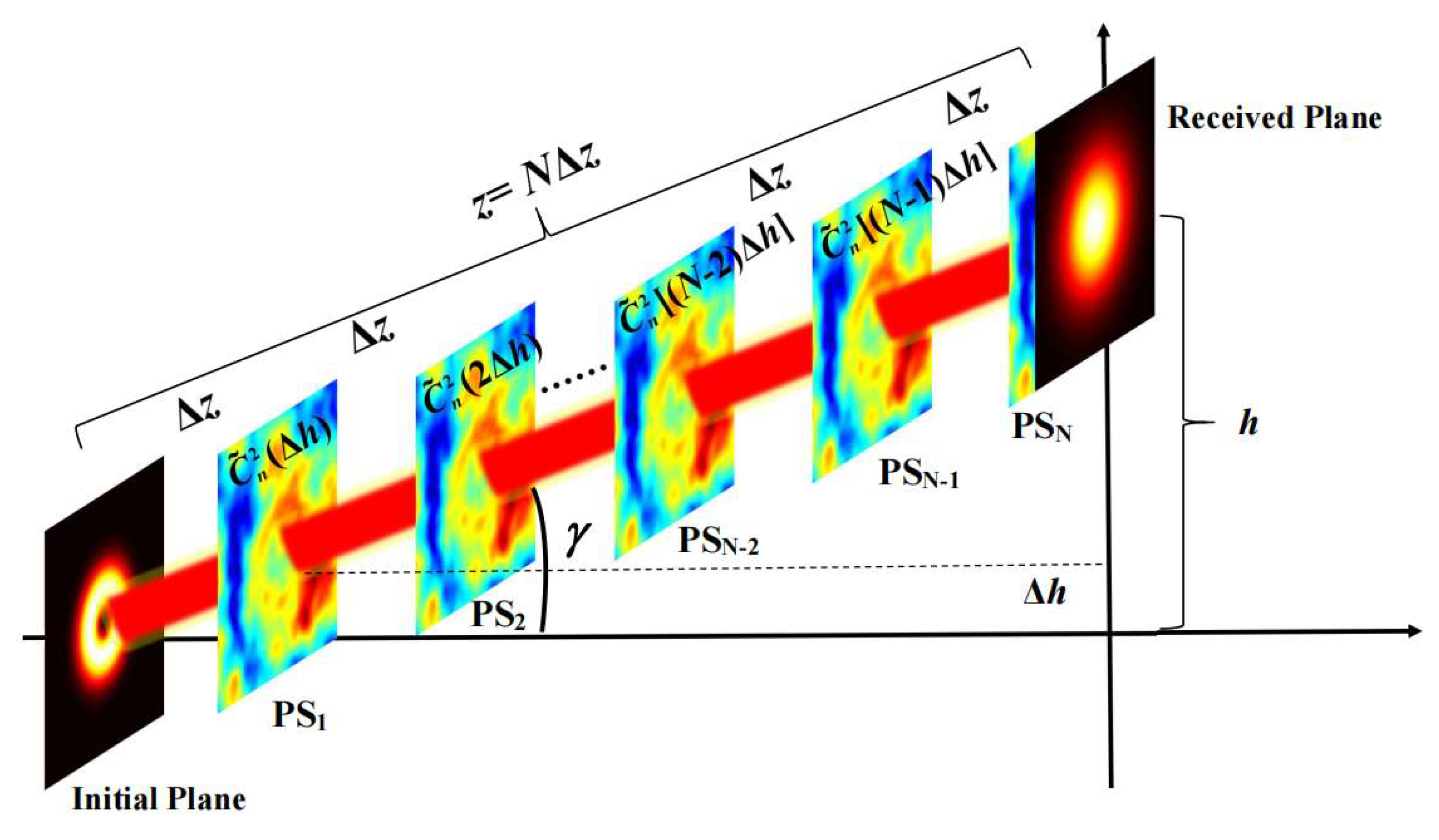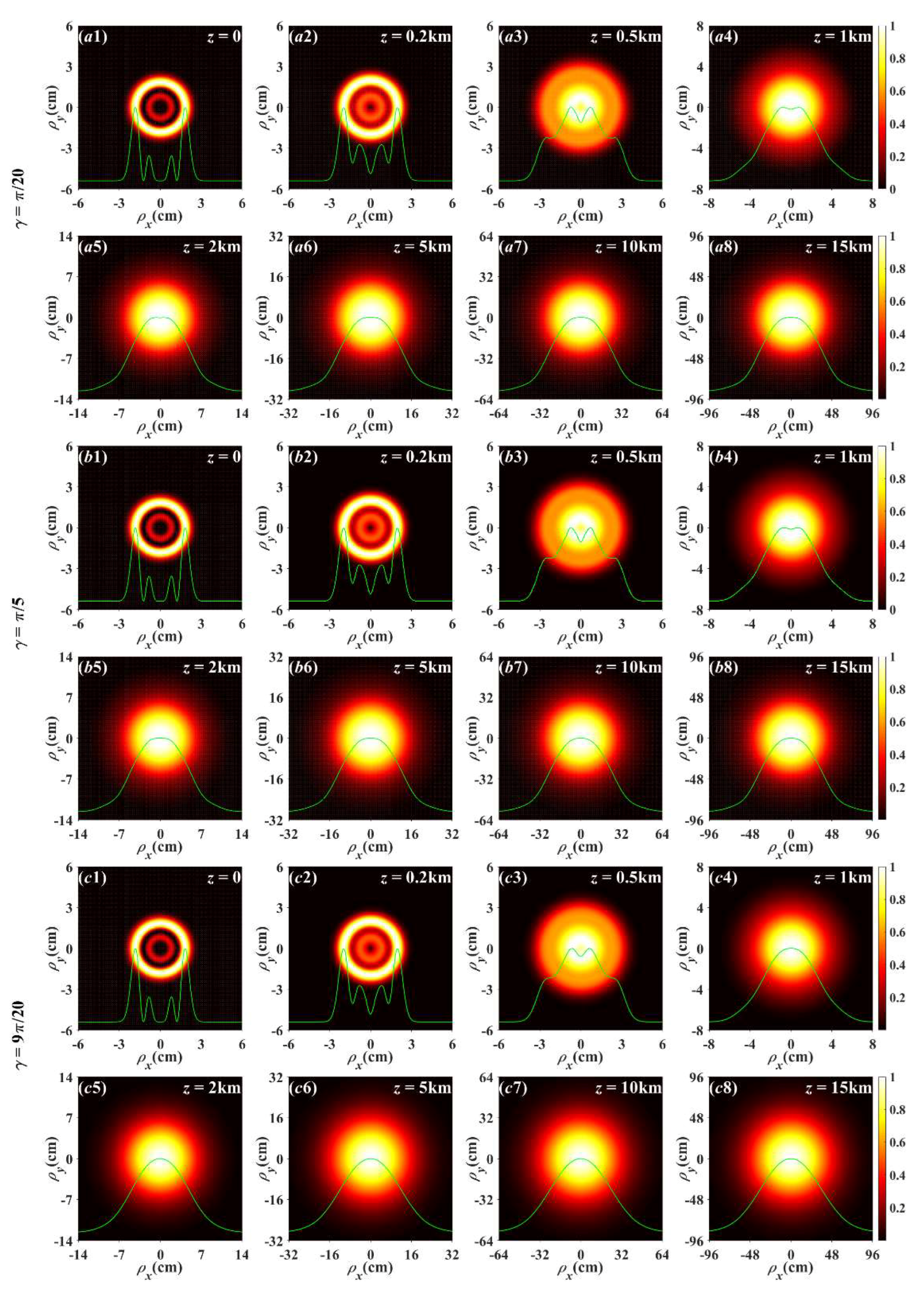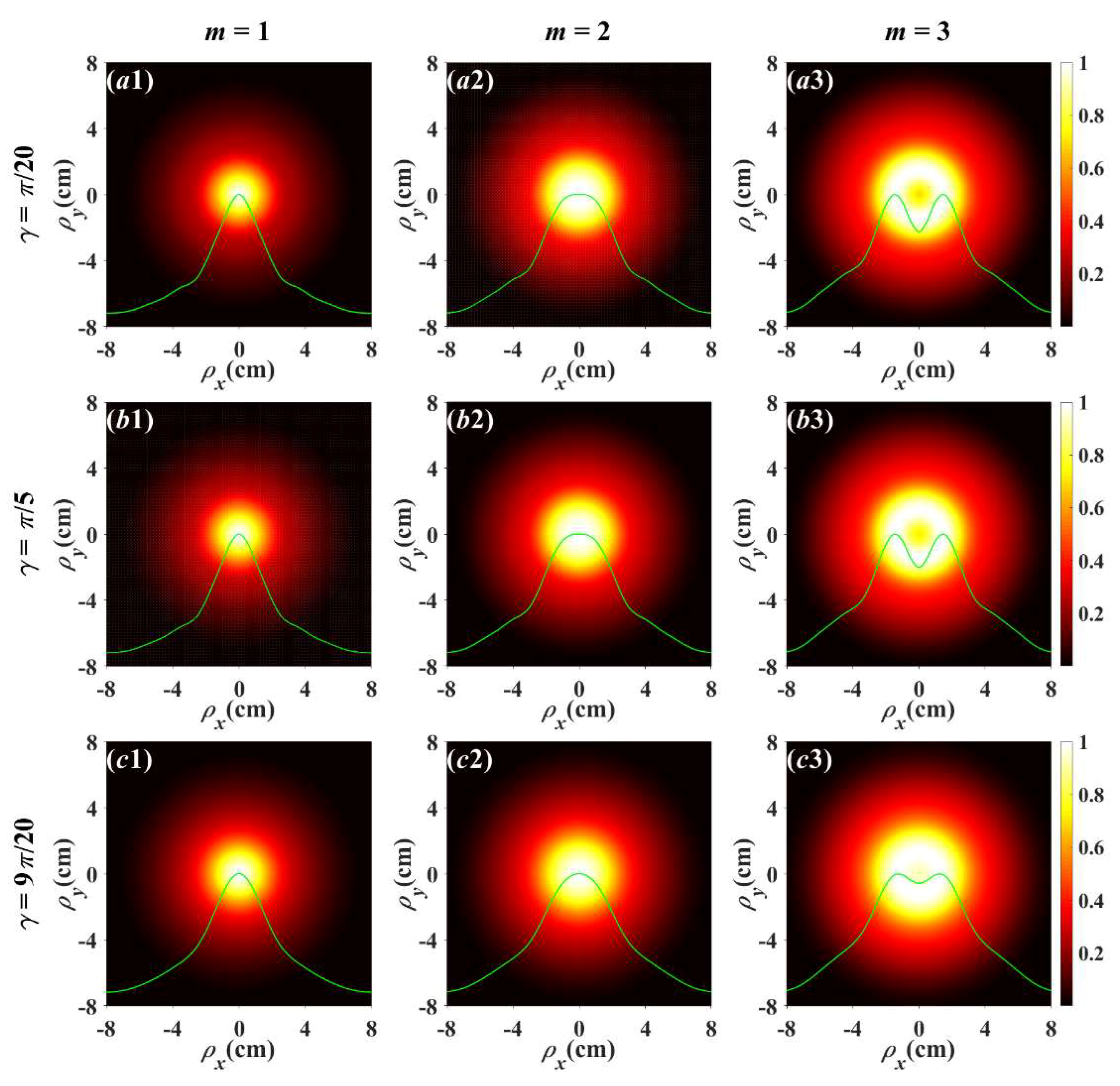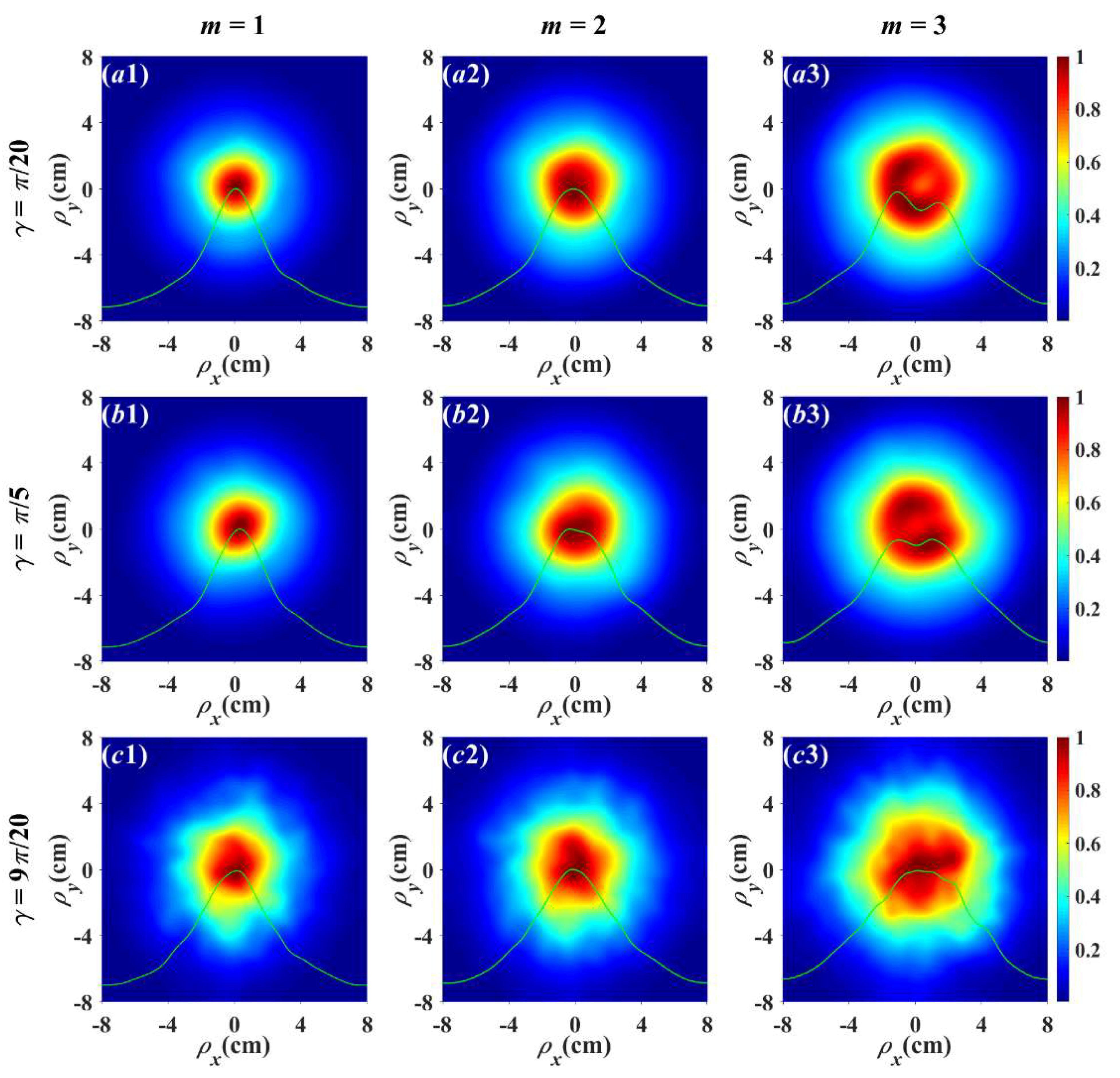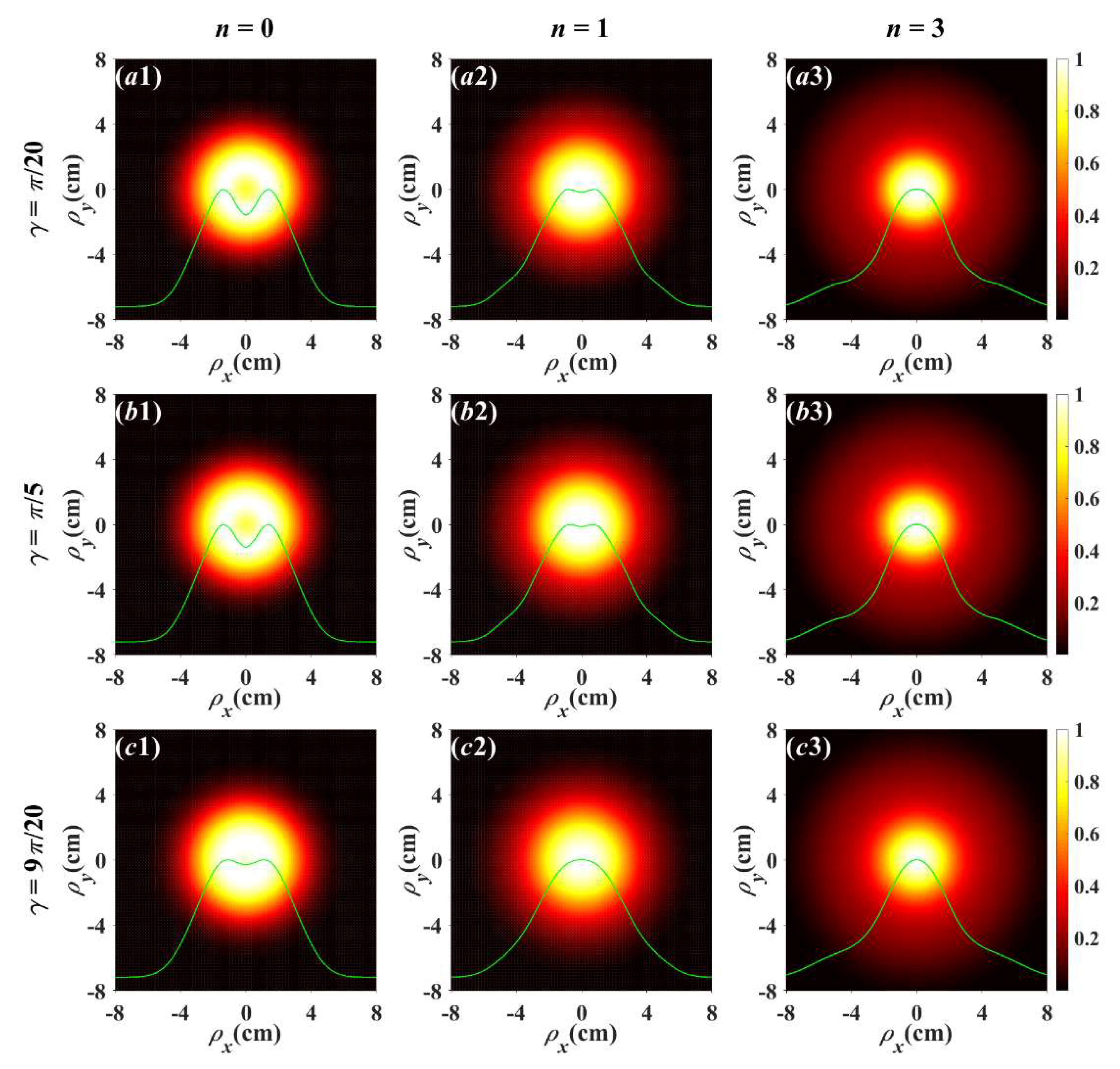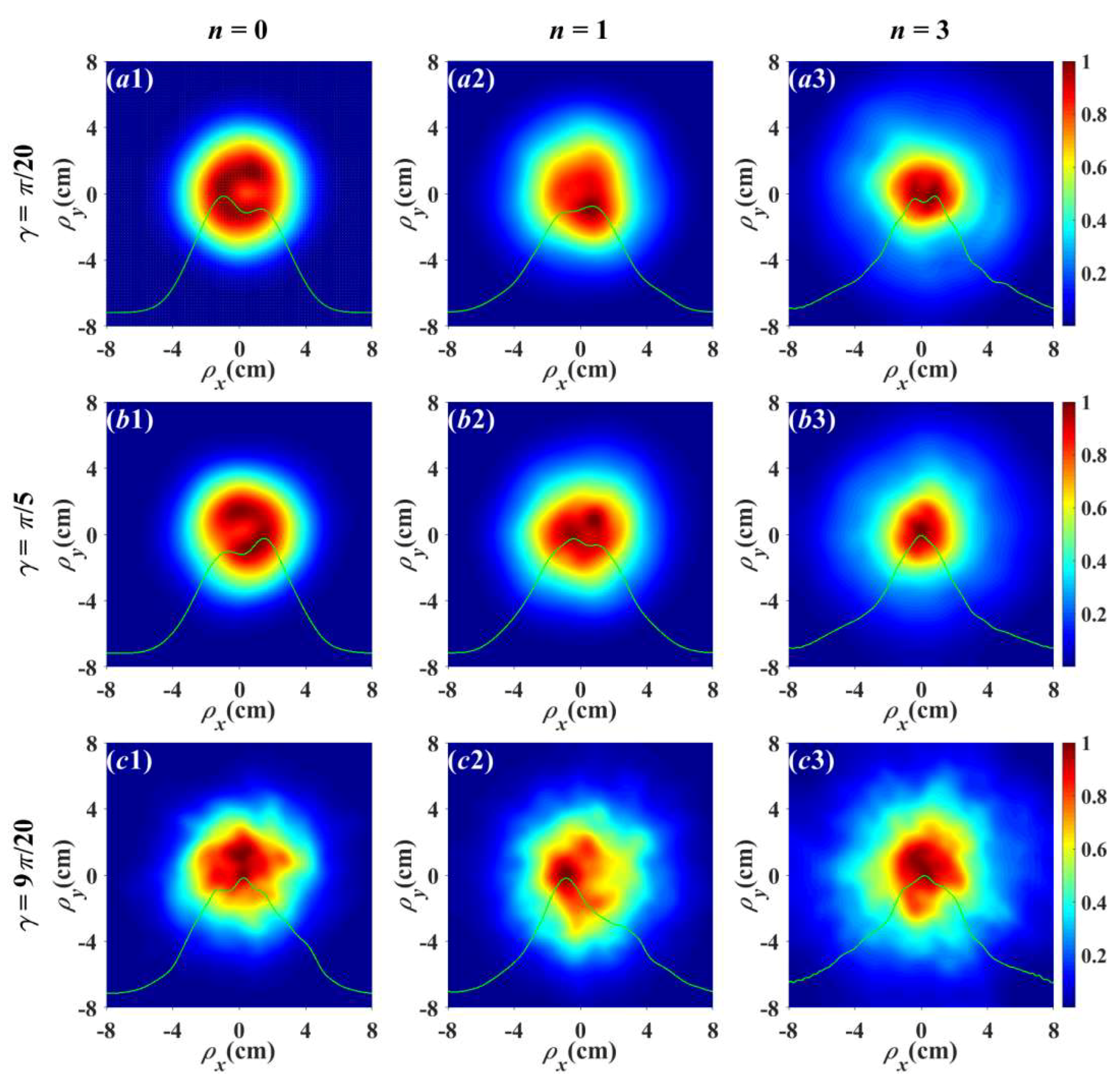1. Introduction
In the past decades, numerous efforts have been devoted to the propagation of partially coherent (PC) beams in atmospheric turbulence due to their important applications in free-space optical communications, lidar distance measurement and remote sensing [
1,
2,
3,
4,
5,
6,
7,
8,
9,
10,
11,
12,
13,
14,
15]. It is generally considered that atmospheric turbulence causes a series of harmful turbulence effects such as scintillation (i.e., intensity fluctuation), phase distortion and so on, which will lead to an increase in the communication error rate and decrease in the channel capacity of the system [
1,
2,
3,
4,
5]. Therefore, it is of practical importance to develop a method to overcome or reduce turbulence effects. It is demonstrated that one may use special beams to achieve this goal [
6,
7,
8,
9,
10,
11,
12,
13,
14,
15]. A PC beam is more suitable for propagation in turbulent media than a fully coherent beam because it is less affected by turbulent media and can effectively mitigate harmful optical phenomena such as beam spreading, drift, scintillation, speckles and uneven intensity distribution [
6,
7,
8,
9,
10,
11,
12,
13]. In 2003, Shirai et al. explained the reason using a coherent-mode representation of the spreading of partially coherent beams propagating through atmospheric turbulence [
3]. In 1992, Allen et. al. found that each photon in a beam with a phase factor exp(imθ) has an orbital angular momentum (OAM) of ħm, where m is the topological charge carried by the beam and ħ is the reduced Planck constant. And this kind of beam with OAM is called a vortex beam [
16,
17,
18,
19], which can reduce the effect of turbulence. Furthermore, PC beams with special spatial structures, such as radially polarized (RP) beams [
6,
7,
8,
9,
10,
11], partially coherent vortex (PCV) beams [
9,
10,
11,
12,
13,
16,
17,
18,
19], partially coherent Laguerre–Gaussian vortex (PCLGV) beams, partially coherent radially polarized Laguerre–Gaussian vortex (PCRPLGV) beams [
10], partially coherent twisted (PCT) beams, partially coherent twisted vortex (PCTV) beams [
14,
15] and so on, can also effectively reduce the effect of turbulence. These special beams have a common characteristic: when they propagate in inhomogeneous atmospheric turbulence, the beam quality is better than that of fundamental mode Gaussian beams, and the evolution of the distribution of these beams during propagation in inhomogeneous atmospheric turbulence is slower, with stronger resistance to atmospheric turbulence, such as the ability of PCV beams, PCLGV beams, PCRPLGV beams and PCTV beams to maintain a hollow distribution during long-distance transmission [
9,
10,
11,
12,
13,
14,
15,
16].
On the other hand, the propagation of most beams in atmospheric turbulence is often assumed to be horizontal (i.e., the structural parameter of the refractive-index fluctuation in turbulence is treated as a constant). However, for some special applications (e.g., lidar detection and imaging, remote sensing), these beams propagate in atmospheric turbulence along a slant path, and the structural parameter of the refractive-index fluctuation in turbulence is variable [
4,
6,
12,
20,
21,
22,
23,
24,
25]. As is well known, in the practical applications of LiDAR (including ground-based LiDAR or vehicular LiDAR) in atmospheric detection and imaging, laser satellite ranging and lunar laser ranging, the intensity of atmospheric turbulence changes with transformation of ground height and induces variation in the phase structure of the emitted beam. Therefore, studying the propagation characteristics of partially coherent special structure beams in atmospheric turbulence should consider turbulence to be inhomogeneous atmospheric turbulence.
Up to now, to the best of our knowledge, the average intensity of a partially coherent Laguerre–Gaussian vector vortex (LGVV) beam through inhomogeneous atmospheric turbulence has not been reported. In this paper, we first derive the analytical formulae for the elements of the cross-spectral density matrix of a partially coherent LGVV beam propagating in turbulence with the help of the extended Huygens–Fresnel principle, then we study the evolution laws of the average intensity of partially coherent beams in turbulence, analyze the effect of beam parameters and turbulence parameters on them and obtain the main parameters that affect the average intensity distribution of partially coherent beams propagating through inhomogeneous atmospheric turbulence. Finally, we use the multi-phase screen method to confirm our theoretical results and show that the simulation results are in good agreement with theoretical predictions; we also find that the accuracy of the physical image is related to the number and interval of phase screens. These results are of interest for the optimization of earth-satellite communications and imaging links as well as in astronomical studies.
2. Theoretical Model
The electric field of a full coherent LGVV beam in cartesian coordinates is expressed as [
9,
10,
11]:
where
r = (
x,
y) is an arbitrary transverse position vector in the initial plane,
w0 represents the beam waist for the fundamental Gaussian beam,
m and
n denote the topological charge number and the radial index, respectively, and
ex and
ey are the unit vectors in the
x and
y directions, respectively.
H2t+m−s(·) and
H2n−2t+s(·) are the Hermitian polynomials; we use their summation form to represent the Laguerre term in the original LGVV beam expression [
14,
15,
26,
27,
28,
29,
30]. And
and
are the binomial coefficients.
Then, we extend the beam to a partially coherent form and consider that its coherent structure satisfies a Gaussian distribution. Its second-order statistical properties are characterized by a 2 × 2 cross-spectral density matrix (CSDM) as [
9,
10,
11]:
where
r1 = (
x1,
y1) and
r2 = (
x2,
y2) are two arbitrary transverse position vectors in source plane (
z = 0). The elements
Wxx(
r1,
r2;0),
Wxy(
r1,
r2;0),
Wyx(
r1,
r2;0) and
Wyy(
r1,
r2;0) of the CSDM for a partially coherent LGVV beam in the initial plane can be written as the following expressions [
9,
10,
11]:
where
Ex and
Ey are the two components of the stochastic electric vector in the
x and
y directions, respectively,
α,
β = x,
y. 〈·〉
m denotes the ensemble average and ‘*’ represents the complex conjugate.
δαβ represents the initial auto-correlation lengths (when
α = β) and the initial mutual correlation lengths (when
α ≠
β), respectively. And here, in order to calculate conveniently, in this paper, we set
δxx = δyy = δxy = δyx = δ0. Equation (3), especially, reduces to the cross-spectral density (CSD)
Wαβ(
r1,
r2;0) of a radially polarized vortex beam for
n = 0 and
m ≠ 0, a radially polarized hollow beam for
m = 0 and
n ≠ 0 and a radially polarized beam for
n = 0 and
m = 0, respectively.
With the validity of approximate paraxial solutions, the elements of CSDM for a partially coherent LGVV beam propagating through inhomogeneous atmospheric turbulence can be related with those in the source plane with the help of the following extended Huygens–Fresnel principle integral formula [
31,
32,
33,
34,
35]:
W = where
ρ1 = (
ρx1,
ρy1) and
ρ2 = (
ρx2,
ρy2) are positions of two points in the received plane,
k = 2
π/
λ represents the wave number with
λ being the wavelength and
z denotes the propagation distance of a partially coherent LGVV beam propagating through inhomogeneous atmospheric turbulence.
Dw (
r1 −
r2,
ρ1 −
ρ2;
z), which is a two-point spherical wave structure function containing the effect of inhomogeneous atmospheric turbulence, is given by [
20,
21,
22,
23,
24,
25]:
where
γ is the zenith angle,
J0(·) is the zero-order Bessel function of the first kind and Φ
n(
κ,
h) =
(
h)Φ′
n(
κ) represents the spatial power spectrum of the refractive-index fluctuations in inhomogeneous atmospheric turbulence, with
κ and
h denoting the spatial wavenumber and propagation height, respectively.
(
h) is the generalized refractive-index structural parameter varying with propagation height
h.
H is the height between the receiving plane and the ground, and
h0 is the height between the light source plane and the ground. In general, we consider that the light source is on the ground, that is,
h0 = 0. And
ζ = 1 −
h/[
zcos(
γ)] denotes the normalized distance variable with
z =
H/cos(
γ) being the total propagation distance along a slant path [
4,
20,
21,
22,
23,
24,
25].
In Equation (5), we consider the first-order approximation of
J0(·); then, Equation (5) can be rewritten as:
where
The average intensity of a partially coherent LGVV beam propagating through inhomogeneous atmospheric turbulence is given by:
We set
ρ1 =
ρ2 =
ρ = (
ρx,
ρy); so, Equation (4) can be simplified as:
By substituting Equation (3) into Equation (12), after the tedious integral, the analytical formulas for
Wxx (
ρ,
ρ;
z) and
Wyy (
ρ,
ρ;
z) of a partially coherent LGVV beam through inhomogeneous atmospheric turbulence can be obtained with the following expressions:
and
where
Equations (13) and (14) are the analytical formulae of a partially coherent LGVV beam propagating through inhomogeneous atmospheric turbulence based on the quadratic approximation of the Rytov phase structure function. It can be seen that the average intensity of a partially coherent beam in turbulence is mainly determined by the propagation distance z, topological charges m, radial index n and zenith angle γ.
3. Numerical Examples, Simulations and Discussions
In this paper, we adopt the non-Kolmogorov power spectrum for the power spectrum of the refractive-index fluctuation of the inhomogeneous atmospheric turbulence, and the spatial power spectrum Φ
n(
κ,
h) is given by [
4,
20,
21,
22,
23,
24,
25]:
where
κ0 = 2
π/
L0 with
L0 being the outer scale of atmospheric turbulence and
κm =
c(
α)/
l0 with
l0 being the inner scale of atmospheric turbulence.
α (3 <
α < 4) is the generalized exponent parameter, and
Γ(·) is the gamma function. For a zenith angle of
α = 11/3,
c(11/3) = 5.91,
κm = 5.91/
l0,
A(11/3) = 0.033 and
L0 = ∞, and Equation (16) reduces to the Tatarskii spectrum; furthermore, the spectrum expressed in Equation (16) reduces to the classical Kolmogorov spectrum when
α = 11/3,
L0 = ∞ and
l0 = 0.
(
h) is generally described by the Hufnagel–Valley inhomogeneous atmospheric turbulence profile model (H-V5/7 model) [
4,
20,
21,
22,
23,
24,
25]:
where
v denotes the wind speed, which is usually taken as 21 m/s.
Substituting Equations (16)–(18) into Equation (10), we obtain:
Then, we substitute Equation (19) into Equation (9) and obtain:
Using Equations (13)–(14) and (20)–(21), we can easily obtain the average intensity of a partially coherent LGVV beam propagating in inhomogeneous atmospheric turbulence.
In addition, it is well known that the random phase screen (RPS) is an important method for simulating a beam propagating in atmospheric turbulence. Thus, we also use the RPS to simulate the propagation behaviors of a partially coherent LGVV beam in turbulence along a slant path. The core idea of the RPS is to regard the beam propagation process in atmospheric turbulence as two independent and simultaneous processes: vacuum propagation and phase modulation of an atmospheric turbulence medium [
9,
10,
11,
12]. Therefore, we can use a series of phase screens (PSs) spaced at Δ
z to replace the continuous random medium on the propagation path. A beam on the source plane passes through these PSs in turn to simulate the turbulence modulation effect and finally reaches the receive surface.
The simulation process can be characterized by [
9,
10,
11,
12]:
where
zi−1 and
zi represent the position of the (
i − 1)-th and
i-th PS,
Ei−1 (
x,
y;
zi−1) and
Ei (
x,
y;
zi) are the fully coherent light field on the (
i − 1)-th and
i-th PS,
ϕ (
x,
y;
zi) denotes the phase distribution in the
i-th PS and
F and
F−1 denote the Fourier transform and inverse Fourier transform, respectively.
The simulation process of the RPS of a partially coherent LGVV beam propagating in inhomogeneous atmospheric turbulence is different from that of horizontal propagation [
9,
10,
11,
12]. The main differences are as follows: the inhomogeneous atmospheric turbulence power spectrum used to generate the turbulence phase screen by the power spectrum inversion method changes with increasing propagation distance. In this paper, a schematic diagram of the simulation of the propagation of a partially coherent LGVV beam in inhomogeneous atmospheric turbulence is shown in
Figure 1. We synthesized the turbulent phase with turbulent information and extended the RPS to the PC beam field by combining the complex screen (CS) method and multi-phase screen method. In summary, the logical process of numerical simulation of PC beams in atmospheric turbulence is described as follows. (1) Synthesize the corresponding turbulence PS and fix it on the propagation path. (2) Use
J1 CSs to synthesize a PC beam, and the electric field of each frame passes through the above PS fixed on the propagation path separately. It should be especially pointed out that the PS is variable. (3) The average value of the light intensity of
J1 frames on the receiving plane is a frame PC beam after propagating the atmospheric turbulence along the slant path. (4) Cycle steps (1)–(3)
J2 times to obtain the
J2 frame results of a PC beam through inhomogeneous atmospheric turbulence and use the
J2 frame results to analyze and calculate the statistical characteristics of PC beams through atmospheric turbulence along the slant path.
J1 and
J2 denote the number of CS and PS changes, respectively [
9,
10,
11,
12].
Next, we present some numerical examples to study the evolution behavior of the average intensity of a partially coherent LGVV beam propagating in inhomogeneous atmospheric turbulence. To facilitate this comparison, we fix some calculation parameters as follows: α = 3.4, λ = 632.8 nm, w0 = 10 mm, δ0 = 20 mm, L0 = 100 m and l0 = 10 mm. In the simulation of beam propagation, the distance between each two PSs is Δz = 50 m, and the number of data acquisition samples is set to 512 × 512. We take J1 = 200, that is, one frame of instantaneous intensity of a partially coherent beam propagating through inhomogeneous atmospheric turbulence is simulated by the average intensity over 200 cycles. And the conversion times of PS are J2 = 200, i.e., 200 frames of instantaneous light intensity of a partially coherent LGVV beam in inhomogeneous atmospheric turbulence are collected at the receiving plane, and the average of these 200 frames of instantaneous intensity is the final average intensity of a partially coherent LGVV beam through inhomogeneous atmospheric turbulence.
In
Figure 2, we calculate the distribution of the normalized average intensity of a partially coherent LGVV beam with
m = 2 and
n = 1 through inhomogeneous atmospheric turbulence with different zenith angles at different propagation distances. It can be clearly found from
Figure 2 that the beam profile on the initial plane is distributed in concentric rings [see
Figure 2(a1,b1,c1)], and the intensity of the outer ring is higher than that of the inner ring. With the increase in the propagation distance, the dark spots and dark rings in the beam profile gradually decrease [see
Figure 2(a2,b2,c2)], the central light intensity increases continuously, and the beam finally converts into a Gaussian-like beam distribution in the far field. We also find that a partially coherent LGVV beam will evolve into a Gaussian-like beam when it propagates 5 km from where the beam is emitted at the zenith angle of π/20 [see
Figure 2(a6–a8)]. However, this evolution decreases to 2 km and 1 km for the zenith angles of π/5 [see
Figure 2(b5–b8)] and 9π/20 [see
Figure 2(c4–c8)], respectively. It also shows that the evolution behavior of a partially coherent LGVV beam in inhomogeneous atmospheric turbulence is greatly affected by the zenith angle. The larger the zenith angle is, the faster the beam evolves into a Gaussian-like beam [see
Figure 2(c1–c8)] because the intensity of inhomogeneous atmospheric turbulence decreases as altitude increases. For the same propagation distance, the smaller the zenith angle is, the higher the propagation height above the ground of the beam is. The beam can quickly propagate into a weak atmospheric turbulence region, and the beam will be less affected by the cumulative influence of inhomogeneous atmospheric turbulence. In addition, we present some interesting physical phenomena in
Figure 2. For different zenith angles (or inhomogeneous turbulence intensities), when a partially coherent LGVV beam propagates over short distances (z < 0.5 km), the evolution characteristics of the beam are almost independent of the turbulence intensity, and free-space diffraction plays a dominant role in the evolution of the beam. However, for long-distance propagation of a partially LGVV beam in atmospheric turbulence (z > 5 km), the effect of atmospheric turbulence on the phase structure of the emitted beam is greater with the increase in the zenith angle due to the cumulative effect of turbulence, which will accelerate the degradation of a partially coherent LGVV beam to a Gaussian-like distribution.
Figure 3 displays the normalized average intensity distribution of a partially coherent LGVV beam with different topological charge
m through inhomogeneous atmospheric turbulence with different zenith angles at a propagation distance of
z = 1 km. One can see that a partially coherent LGVV beam with a large
m has a larger light spot. And under the same propagation distance, the larger the topological charge
m is, the smaller the degree of hollowness (DOH) of the beam and the slower the beam degenerates into a Gaussian-like beam (in this paper, DOH is defined as the ratio of central light intensity to maximum light intensity). This indicates that a partially coherent LGVV beam with a large
m has a stronger ability to resist atmospheric turbulence. In order to confirm the theory model, the RPS method is used to simulate the propagation characteristics of a partially coherent LGVV beam in turbulence along a slant path, and the simulation results are shown in
Figure 4. The calculated parameters in
Figure 4 are the same as those in
Figure 3. One can easily observe that the simulation results agree well with the theory, which indicates that our simulation model is valid and that the theoretical results are correct. Now, we explain the reasons for the physical phenomena in
Figure 3 and
Figure 4. As is well known, the orbital angular momentum of partially coherent vortex beams [
9,
10,
11,
25,
33] can be given by
mħ, and the larger the topological charge
m is, the greater the orbital angular momentum. The smaller the influence of turbulence on the propagation of a partially coherent LGVV beam in atmospheric turbulence is, the stronger the ability to maintain a dark hollow shape. In
Figure 4, the accuracy of the physical image is related to the number and interval Δ
z of phase screens.
Further, to investigate the effect of radial index n on beam evolution behavior, in
Figure 5, we show the distribution of the normalized average intensity of a partially coherent LGVV beam with different
n through inhomogeneous atmospheric turbulence with different zenith angles at a propagation distance of
z = 1 km. It can be found from
Figure 5 that the influence of radial index
n is quite different with topological charge
m. It demonstrates that the larger
n of a partially coherent LGVV beam is, the larger the DOH of the beam in inhomogeneous atmospheric turbulence, and the easier the beam tends to be the Gaussian-like distribution. This indicates that a partially coherent LGVV beam with a small radial index
n has a stronger ability to resist atmospheric turbulence. Similarly, we also simulate the theoretical results shown in
Figure 5, and the results are shown in
Figure 6. The calculated parameters in
Figure 6 are the same as those in
Figure 5. We also find that
Figure 6 is in good agreement with
Figure 5. Now, we explain the reasons for the physical phenomena in
Figure 5 and
Figure 6. As is well known, the radial index n of partially coherent higher-order Laguerre–Gaussian vortex beams [
10,
30] will determine the dark rings. The larger n of the beam is, the more dark rings there are, and inhomogeneous atmospheric turbulence will cause an interaction between them; therefore, the DOH of the beam in inhomogeneous atmospheric turbulence will become large. In
Figure 6, the accuracy of the physical image is also related to the number and interval of phase screens.
